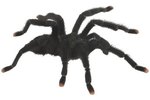Finding suitable caging for your pet python can be challenging. Commercially produced cages often must be mail ordered, will have high shipping costs and must be purchased sight unseen. By contrast, aquariums are affordable options that are readily available in most pet stores. Though aquariums are not designed for reptiles, and require small modifications to accommodate a pet snake properly, they can make fine enclosures for some python species,
Applicability
Though juvenile pythons of any species can be kept in aquariums, only a handful of species can be maintained in an aquarium for their entire lives. Those species that are best suited to aquariums are ball pythons (Python regius), Savu pythons (Liasis savuensis), members of the Children's python complex (Antaresia sp.), green tree pythons (Morelia viridis) and small Morelia species, like Tanimbar pythons (Morelia nauta). While a few aquariums over six feet in length are available commercially, aquariums of this size are very expensive, heavy and difficult to secure. For species requiring very large enclosures, commercially produced or custom-built reptile cages are more cost effective and appropriate.
Size and Layout
The overall size and layout of the enclosure are especially important considerations when using an aquarium for your python, because aquariums are designed with a footprint appropriate for fish, rather than reptiles. Fish and snakes use their enclosure space differently. Fish thrive in the vertical orientation of most aquariums, while snake's will benefit from more front-to-back space. For ball pythons, Children's pythons and savu pythons, a 20-gallon "long" aquarium provides enough space, but a 40-gallon "breeder" tank would be preferable. Adult green tree pythons and their similarly sized kin should be housed in habitats with approximately six square feet of space, approximately the size of a 75-gallon aquarium. It is unnecessary to provide as much cage height as is commonly supposed for arboreal species, and heights over 30 inches provide little benefit, and are harder to heat. In most cases 18- to 24-inch high cages are sufficient.
Heating
There are a number of ways to heat an aquarium, including heat lamps, heating pads, heat tape and radiant heat panels. The method for heating will dictate the type of top that should be used. Heat lamps will require a screen top, while heating pads, heat tape or radiant heat panels can be used with a solid top. Heat lamps provide the most affordable option, as they do not require the use of a thermostat, and are adjustable by changing the wattage of the bulb used. Heating pads and radiant heat panels allow more precise control of the cage temperature, but require the use of a thermostat. Care must be exercised when heating sources are attached to the glass, as excessive temperatures can cause the glass to crack.
Top
Aquariums typically are sold without a lid, so a lid will have to be purchased separately or built. Two basic styles of lid are appropriate: a screened lid or a solid top with ventilation holes. Screened lids can be made easily by attaching plastic-coated hardware cloth to a lumber frame, and attaching a locking mechanism. Commercially produced screen lids are available, but can be difficult to render escape-proof. Solid tops can be made of wood, acrylic or opaque plastic. Ventilation holes (1/4 inch) must be included to provide air flow.
Furnishings
Different species of pythons will require different cage furnishings. Ground dwelling snakes, like ball pythons and blood pythons (Python brongersmai), should be provided with low hide boxes that will make them feel secure. Arboreal pythons of the genus Morelia also must have branches for climbing. It can require some ingenuity to attach branches to the glass walls. One possible work-around is to use a complex branch that can rest on the floor while still offering elevated climbing opportunities. Another choice is to silicone closet-rod holders to the sides, and use an appropriate-size branch. It is important to have removable perches so that they can be cleaned.
Aquarium-Like Snake Cages
Some aquarium manufacturers produce glass cages that are designed for snakes and lizards instead of fish. These typically have dimensions better suited for reptiles than fish, and feature screened lids that slide into place. By incorporating sliding lids, the cages are quite secure for all but the smallest snakes.
References
- Vida Preciosa International: Blood Pythons, Information and Care
- Aquarium Dimensions: Standard Aquarium Sizes
- Melissa Kaplan's Herp Care Collection: Lighting and Heating for Reptiles
- Fine Green Tree Pythons: Caging Information
- Vida Preciosa International: The Ball Python Care Sheet
- Integrated Taxonomic Information System: Pythonidae
Photo Credits
-
Jupiterimages/Photos.com/Getty Images




